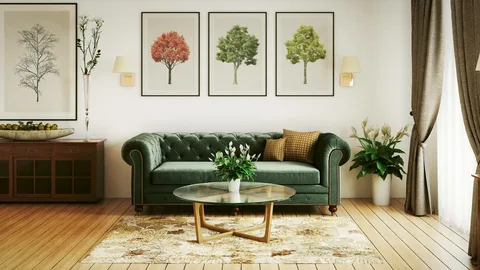
In the relentless rhythm of modern life, the significance of cultivating a sanctuary within our homes has become increasingly evident. Amidst the myriad of interior designing philosophies, the timeless allure of nature-inspired elements continues to captivate homeowners seeking a harmonious blend of aesthetics and well-being. This deep dive into the realm of biophilic design aims to explore the multifaceted ways in which one can infuse the beauty of nature into the heart of their living spaces, creating an environment that not only pleases the eye but also nurtures the soul.
Greenery and Houseplants: An Abundant Oasis Within Four Walls
The most direct conduit to nature within the confines of our homes is the introduction of greenery. Houseplants, ranging from small succulents to majestic potted trees, not only serve as visual delights but also contribute to the improvement of indoor air quality. As you embark on the journey of incorporating greenery into your living spaces, consider the specific needs of each plant. Succulents bask in the glow of sunny windowsills, while ferns and snake plants thrive in the subdued light of interior spaces, offering a myriad of possibilities to tailor your green haven to the unique characteristics of your home.
Natural Materials: Elevating Design with Earthly Elements
The embodiment of nature within the home extends beyond mere foliage. Introducing natural materials into interior design brings forth an immediate sense of earthiness and warmth. From the rustic charm of wooden furniture to the timeless elegance of stone countertops, the selection of materials can significantly influence the ambiance of a space. Bamboo, with its sustainable and versatile nature, can find its place in everything from flooring to decorative elements, creating a seamless connection between the indoor environment and the natural world beyond.
Natural Light and Views: Illuminating Spaces, Connecting with the Outdoors
Maximizing natural light not only reduces the need for artificial illumination but also establishes a profound connection with the outdoors. Strategic furniture placement, coupled with light and airy window treatments, enables the seamless integration of natural light into interior spaces. Additionally, for those fortunate enough to enjoy scenic surroundings, thoughtful design choices such as expansive windows or open spaces can transform the indoors into a canvas that frames the beauty of nature, blurring the boundaries between inside and outside.
Earthy Color Palette: Painting with the Hues of Nature
The selection of a color palette inspired by nature serves as a powerful tool in creating a calming and inviting atmosphere within your home. Earthy tones, ranging from soothing greens to warm browns and calming blues, can emulate the natural world, infusing a sense of serenity and grounding into your living spaces. Whether applied to furniture, decor, or wall paint, these hues become a bridge between the interior environment and the vast palette of the outdoors. Read more: https://www.subsellkaro.com/
Nature-Inspired Art and Decor: Nurturing the Aesthetic Soul
Walls adorned with nature-inspired artwork and decor not only serve as visual focal points but also evoke a profound sense of connection to the environment. Botanical prints, landscape paintings, and sculptures that echo the natural world can transform your living spaces into a curated gallery of elements inspired by the great outdoors. These carefully selected pieces become more than mere decorations; they become windows through which one can gaze upon the wonders of nature from the comfort of their home.
Water Features: Harnessing the Soothing Power of Flowing Water
The therapeutic effect of flowing water is a timeless element that has found its way into interior design. Incorporating water features, whether in the form of tabletop fountains, wall-mounted waterfalls, or indoor ponds, adds a layer of tranquility to the living environment. The gentle sound of flowing water becomes a melodic backdrop, enhancing the overall sense of calm and serenity within the home.
Organic Textures and Patterns: Weaving a Tapestry of Nature
The introduction of organic textures and patterns into interior design mimics the diverse tapestry of nature. Natural fiber rugs, textured fabrics, and patterned wallpapers inspired by elements of the natural world add depth and visual interest to living spaces. These subtle yet intentional details contribute to the creation of an environment that not only looks but also feels connected to the ever-changing patterns and textures of the outdoors.
Biophilic Furniture Design: Embracing Form and Function Inspired by Nature
Choosing furniture that embraces the principles of biophilic design is a key element in creating a holistic living space. Furniture inspired by natural forms and materials, such as tables and chairs that mimic the curvature of leaves or the stability of tree branches, can add a touch of whimsy to your decor. Additionally, incorporating furniture with built-in storage that mirrors natural elements seamlessly blends functionality with design, ensuring that every piece serves a purpose while contributing to the overall aesthetic harmony.
Conclusion:
In the relentless pursuit of a balanced and fulfilling lifestyle, the integration of nature into our interior spaces emerges as a timeless and invaluable approach. Whether through the introduction of greenery, the use of natural materials, or the strategic manipulation of light and space, the goal is to create an environment that transcends the ordinary and reconnects us with the essence of the outdoors. By embracing the principles of biophilic design, we transform our homes into sanctuaries, where the beauty of nature is not just a distant view but an integral part of our daily lives, fostering a sense of well-being, tranquility, and aesthetic delight.
FAQS
Can I incorporate biophilic design in a small living space?
Absolutely! Biophilic design is versatile and can be adapted to spaces of all sizes, including small living areas. Consider using vertical greenery with wall-mounted planters to save floor space, choose furniture with natural materials that add warmth without overwhelming the room, and strategically place mirrors to enhance natural light and create an illusion of space. Additionally, opting for smaller houseplants or selecting furniture with built-in storage can contribute to a seamless integration of biophilic elements in compact interiors.
How can I maintain houseplants indoors, especially if my home has limited natural light?
Maintaining houseplants indoors, even in spaces with limited natural light, is possible with careful consideration. Choose low-light tolerant plants such as snake plants, ZZ plants, or pothos for areas with less sunlight. Rotate your plants regularly to ensure even growth, and be mindful of watering requirements—overwatering is a common issue. Consider supplementing natural light with artificial grow lights designed for plants, especially during the darker months. Additionally, choose the right potting mix, provide adequate drainage, and monitor humidity levels to create a conducive environment for your indoor garden.



